Southern Channel Island Wreck Information
The Channel Islands are very diverse and large with quite a few wrecks. Because of this we have made two separate pages covering the wrecks in the Channel Islands. This one has the wrecks in the four Southern Channel Islands and the other page has the wrecks in the four Northern Islands. We have tried to cover as much of the history and details of each wreck that we could. Some of the wreck diving sites you will find on maps and others you won’t. Over the years, Ken the owner of Channel Islands Dive Adventures has dived most all these wrecks.
We hope you enjoy all the information listed here and come back to read a little each time. There is just way too much to check out at one time.
Star of Scotland
Olympic ll
Palawan
Avalon
Georgia Straits
Ace 1
John C. Butler
Yukon
P-38
Hogan
Ruby E
High Seas
LA County Wrecks
To learn more about Southern California wrecks & wreck diving, please visit the California Wreck Divers (CWD) website along with another excellent resource, the book “Shipwrecks of Southern California” by Bonnie J. Cardone and Patrick Smith. The book is no longer in print but available through Amazon.
Star of Scotland
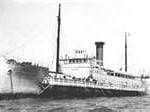 The Star of Scotland started her life as the HMS Mistletoe on April 22, 1918. The type of ship the Star of Scotland was, eventually gave her the name as a Mystery Ship because the crew had the ability to change her appearance in a short time. She was 262′ x 35′ and fast, powered by a steam engine. Over the years the ship went through many owners, names and types of service. After the armistice she was converted to a survey vessel, then a cargo hauler for fruit and later a floating gambling ship.
The Star of Scotland started her life as the HMS Mistletoe on April 22, 1918. The type of ship the Star of Scotland was, eventually gave her the name as a Mystery Ship because the crew had the ability to change her appearance in a short time. She was 262′ x 35′ and fast, powered by a steam engine. Over the years the ship went through many owners, names and types of service. After the armistice she was converted to a survey vessel, then a cargo hauler for fruit and later a floating gambling ship.
In 1940 she was leased and renamed the Star of Scotland and with the propellers removed a number of years earlier she was towed as a barge for fishing in the Santa Monica Bay. Due to some needed repairs and a large storm, the Star of Scotland sunk on January 23, 1942. She now sits 70′ deep a couple miles off the Santa Monica Pier. Visibility can vary from 10′-15′ on an average day to 40′-60′ on a great day. There is still a lot to see on the Star of Scotland and she makes for an excellent dive as long as you watch for hazards like fishing line, old nets and sharp metal.
To read more about the Star of Scotland and learn more about wreck diving, please visit the California Wreck Divers (CWD) website.
Olympic ll
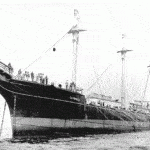 The Olympic started her life as the Star of France. She was built in Ireland in 1877 as a 3 masted ship and was 258′ x 38′. She was later sold and relocated to Washington State in the early 1900’s to haul lumber and later worked in Alaska. She then sat for many years before becoming a fishing barge in 1934. She was then renamed the Olympic ll and moved to San Pedro. She served as a fishing barge for many years until the morning of September 4, 1940 when she was hit by another boat, the Sakito. It was tragic as she sunk fast with the loss of some lives. The Olympic now sits a few miles out of Los Angeles Harbor in 100′ of water.
The Olympic started her life as the Star of France. She was built in Ireland in 1877 as a 3 masted ship and was 258′ x 38′. She was later sold and relocated to Washington State in the early 1900’s to haul lumber and later worked in Alaska. She then sat for many years before becoming a fishing barge in 1934. She was then renamed the Olympic ll and moved to San Pedro. She served as a fishing barge for many years until the morning of September 4, 1940 when she was hit by another boat, the Sakito. It was tragic as she sunk fast with the loss of some lives. The Olympic now sits a few miles out of Los Angeles Harbor in 100′ of water.
Diving the Olympic ll can be a fun dive with good conditions or challenging with poor conditions. Visibility can be anywhere from a few feet to 50’ plus. She sits on her starboard side and relatively intact with the bow standing some 30 feet off the bottom. All though there is no penetration diving on the Olympic ll there are still hazards to be aware of and even more so when the visibility is poor.
To read more about the Olympic ll and learn more about wreck diving, please visit the California Wreck Divers (CWD) website.
Palawan
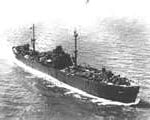
Launched at Bethlehem’s Baltimore shipyard in Aug. 1944, the vessel was initially to be a cargo carrying Liberty Ship.. However before she was commissioned, she was acquired by the Navy and converted to an Internal Combustion Engine Repair Ship and arrived in the Philippines in August, 1945. USS PALAWAN spent the remainder of the war and a good period of post-war service supporting the fleet in Japan, China and other areas of the Far East. PALAWAN was decommissioned 16 June 1947 and initially was laid-up in in the Pacific Reserve Fleet, San Diego, CA. On 14 March 1962 she was transferred to the Maritime Administration for relocation and layup in the National Defense Reserve Fleet, Suisun Bay, Benicia, CA.
PALAWAN was struck from the Naval Register early in 1962 and remained out of service until obtained in 1976 by the California Department of Fish and Game as part of an artificial reef project. She was to be the first of three Liberty-type ships to be sunk off the coast.
In September 1977, under the guidance of a US Navy demolition team, the PALAWAN was sunk a short distance off King Harbor, Redondo Beach. Today the ship sits upright in 120 feet of water and has become a vibrant artificial reef. Over the years the CDF&G has added additional materials around the site including concrete piles and freeway rubble and these along with the ship make it an interesting and exciting dive whether for hunter or photographer.
Because of the depth the PALAWAN is considered an advanced dive. Careful consideration must be given to gas usage and bottom time.
To read more about the Palawan and learn more about wreck diving, please visit the California Wreck Divers (CWD) website. Thank you to Patrick Smith for supplying the information listed here.
Avalon
 The AVALON was the well known and loved steamer that made thousands of crossings between L.A. Harbor and the city of Avalon on Catalina Island. Beginning in early 1920, and retired in 1951, the ship was one of the best-known vessels on the Southern California coast.
The AVALON was the well known and loved steamer that made thousands of crossings between L.A. Harbor and the city of Avalon on Catalina Island. Beginning in early 1920, and retired in 1951, the ship was one of the best-known vessels on the Southern California coast.
Built in 1891 in Cleveland, Ohio for the Goodrich Line, she was launched as the S.S. VIRGINIA and was one of the most luxurious vessels in the US commercial fleet. In 1919 she was sold to William Wrigley and brought to Los Angeles via the Panama Canal. Beginning in April, 1920 she would run almost continuously for the next 31 years.
In 1951, she was sold and a series of owners modified her, removed her machinery and finally cut her down to a barge. In 1964 while being used for the salvage of the stranded freighter DOMINATOR on Rocky Point (Palos Verdes Point), she was overcome during a violent storm and foundered a short distance northwest of the salvage site.
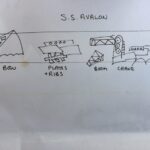 Today the AVALON lies in about 75 feet of water, her hull broken and scattered across the rocky bottom. The bow is laying on its starboard side and is the highest structure on the wreck. At the stern, the salvage crane is the most prominent structure and is often shrouded in clouds of Sargo and Blacksmith. The remainder of the ship is flattened along the bottom, its structure providing nooks and crannies for hunter and photographer alike.
Today the AVALON lies in about 75 feet of water, her hull broken and scattered across the rocky bottom. The bow is laying on its starboard side and is the highest structure on the wreck. At the stern, the salvage crane is the most prominent structure and is often shrouded in clouds of Sargo and Blacksmith. The remainder of the ship is flattened along the bottom, its structure providing nooks and crannies for hunter and photographer alike.
To read more about the Avalon and learn more about wreck diving, please visit the California Wreck Divers (CWD) website. Thank you to Patrick Smith for supplying the information listed here.
Georgia Straits
The Georgia Straits was built in 1905 in Vancouver, British Columbia as the “Belle” and served many years in the same area as the “Belle” until being sold and renamed in 1942 as the Georgia Straits. At a size of 92′ x 18′, she was a smaller tug then most and powered by a steam engine and refitted to a diesel in 1932. She may have been smaller but she was built like a work horse. In 1964 the Georgia Straits was sold again and moved to San Francisco where problems arose with her new owner and she was once again sold again and moved to Los Angeles.
While her new owner and about a dozen guests were out on a very foggy day in August 1965 she was hit by a tanker. With some failed attempts to try and plug the large hole and help they received from the Coast Guard she sunk.
The Georgia Straits now sits on a sandy bottom at a depth of 80′. She is only a few miles out of the San Pedro harbor making for a quick dive. Because of where she sits the conditions are not usually that great but on a very good day you may have 25′-30′ of visibility and on the not so good days it might only be 5′ of visibility. The Georgia Straits is broken down quite extensively is more of a smaller debris field now with the largest piece being the engine. Now she is a very pretty artificial reef with lots of bared sand bass, a halibut or two and other smaller schools of fish calling the wreck their home and on the few larger pieces that remain there are lots of sea fans and metridums living on them making for a very photogenic dive.
To read more about the Georgia Straits and learn more about wreck diving, please visit the California Wreck Divers (CWD) website.
Ace 1
The Ace 1 was 150′ x 23′ and built in 1944 at the Commercial Iron Works of Portland, Oregon where she was originally built as the LCI (L) 735.
Her war career was short and began in September 1944 when she participated in the Capture and Occupation of Palau Island in the Western Caroline Island Group until October 1944. She served until December 1945 and shortly thereafter, she returned to the USA where she was decommissioned. She was then one of five LCIs sold to a company in Terminal Island for scrap. After salvaging her engines and machinery, her hull was sold and used as a fishing barge, moored off Dana Point in April of 1948.
Six days after being licensed to operate legally, a storm came up and she dragged anchor with her resting on the rocky shore. The caretaker was able to jump overboard and climbed up on the bluff just north of Dana Point. She was considered a total loss and pulled off by several tugs. While under tow towards San Pedro/Long Beach harbor, she “became a menace to navigation” and was sunk at a depth of 125′ by the CG-83337 about 7 miles south of the breakwater.
The Ace 1 is not visited by divers very often and as a result the marine life on the wreck is large and not used to seeing divers. There are lots of metridums, sea fans fish and maybe a wolf eel or two to see. The Ace 1 is a large wreck with much to see, but given the depth, bottom time is very limited. Also because of the depth, potential currents and hazards, a dive on the Ace 1 should only be done by advanced divers with the experience to make such a dive. The wreck is lying upside down and only stands no more than 10′ off the bottom. Over time she is starting to fall apart and any penetration that may be possible is highly not recommended due to the extreme hazards that it would pose.
To read more about the Ace 1 and learn more about wreck diving, please visit the California Wreck Divers (CWD) website.
John C. Butler
John C. Butler: Hero of Midway
For extraordinary and distinguished service as a pilot of an airplane of Bombing Squadron Three in action against enemy Japanese forces in the Battle of Midway during the period June 4-6, 1942. Defying the extreme danger from a concentrated barrage of anti-aircraft fire and fierce fighter opposition, Ensign Butler, with utter disregard for his personal safety, participated in persistent and vigorous attacks against the Japanese invasion fleet. His gallant intrepidity and loyal devotion to the accomplishment of a vastly important objective contributed in large measure to the success achieved by our forces and were in keeping with the highest traditions of the United States Naval Service.
-Ensign John C. Butler’s Navy Cross Citation
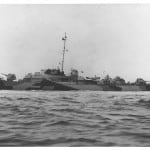 The Battle of Midway was the turning point of World War II in the Pacific theater. It pitted a smaller American task force strengthened with superior military intelligence against one of the most potent naval forces ever assembled. The odds were overwhelmingly in favor of the Japanese. Among the brave navy and marine pilots who fought in that crucial battle was John C. Butler of Buckeye, Arizona.
The Battle of Midway was the turning point of World War II in the Pacific theater. It pitted a smaller American task force strengthened with superior military intelligence against one of the most potent naval forces ever assembled. The odds were overwhelmingly in favor of the Japanese. Among the brave navy and marine pilots who fought in that crucial battle was John C. Butler of Buckeye, Arizona.
John C. Butler was born in Liberty, Arizona, on February 3, 1921. He attended Liberty elementary school and was graduated from Buckeye Union High School. Butler attended UCLA for a semester before transferring to San Diego State. The navy offered naval flight training and a commission upon graduation, and he signed on. He earned his gold navy wings at Pensacola, Florida, in June 1941 and was then stationed in San Diego.
Butler had just completed his five qualifying landings in the new Douglas SBD-3 dive-bomber when the Japanese attacked Pearl Harbor. He and his squadron were immediately shipped out to the carrier Saratoga. The pilots of the Saratoga flew combat missions until January 11, 1942 when the ship was hit by a torpedo and crippled. Butler and the rest of his squadron were transferred to the carrier Yorktown.
During his tour with the Yorktown, Ensign Butler played a prominent role in Jimmy Doolittle’s raid on Tokyo, one of the most spectacular events of the war. During the mission, Butler sank one Japanese patrol boat and damaged another. On May 30th Ensign Butler and the men of the Yorktown set sail to join the Enterprise and Hornet at Point Luck, 325 miles northeast of Midway for a rendezvous with destiny. 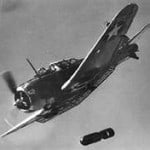
The battle began on June 4th and Ensign Butler’s squadron took off from the Yorktown. Each plane carried a thousand-pound bomb. They found the carrier Kaga and by the time it was Butler’s turn to make his dive, the carrier was in flames. He and the rest of the squadron decided to go after other targets. Butler dove on a battleship and released his bomb. He looked back and saw smoke and flames rising.
As squadron three was coming in for a landing on the Yorktown, the Japanese attacked and the squadron had to land on the Enterprise to refuel and rearm to continue the battle. At half past three, Ensign Butler, along with the other refugee pilots from the Yorktown, joined the pilots from the Enterprise and sped off in pursuit of the fourth and final Japanese carrier. At about quarter to five, they spotted the Hiryu. As the dive-bombers maneuvered around to make their attack from the setting sun, they were jumped by several Zeros desperately trying to save their last carrier.
Despite withering fire, the dive-bombers continued their high-speed run. Three dive-bombers, including Ensign Butler’s, were shot down. Other pilots reported that they had seen him come under attack by a Zero. Butler had always said that he wanted to be a fighter pilot and tangle with a Zero. Unfortunately, his Douglas Dauntless dive-bomber was no match against the speedy, quick-turning Japanese fighter plane.
For his heroism, Butler and six other members of his squadron were awarded the Navy Cross, second only to the Medal of Honor for bravery.
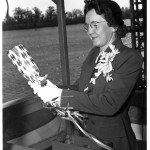 Picture of John’s mother Mrs. Walter C. Butler (Irene) christening the John C. Butler on November 12, 1943
Picture of John’s mother Mrs. Walter C. Butler (Irene) christening the John C. Butler on November 12, 1943
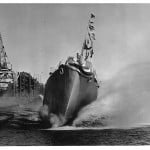 Historically, U.S. Navy battleships are named after states; cruisers are named after cities; and destroyers and destroyer escorts are named after navy and marine heroes. Of the many pilots lost that day, only two pilots, one of them Ensign John C. Butler, were recommended to have destroyers named in their honor. In San Diego, a monument honors eight navy fighting ships, including the USS John C. Butler. The ships won glory for their role in the crucial Battle of Leyte Gulf in 1945. For Ensign Butler’s family, the monument also serves as his tombstone. They never recovered his body.
Historically, U.S. Navy battleships are named after states; cruisers are named after cities; and destroyers and destroyer escorts are named after navy and marine heroes. Of the many pilots lost that day, only two pilots, one of them Ensign John C. Butler, were recommended to have destroyers named in their honor. In San Diego, a monument honors eight navy fighting ships, including the USS John C. Butler. The ships won glory for their role in the crucial Battle of Leyte Gulf in 1945. For Ensign Butler’s family, the monument also serves as his tombstone. They never recovered his body.
All information and pictures supplied by the family of John C. Butler-Thank you!
For more information please visit these links-California Wreck Divers and NavSource
San Diego County Wrecks
The Yukon
 The HMCS Yukon (DDE 263) was launched in North Vancouver and launched on July 27, 1961. She was commissioned into the Royal Canadian Navy (RCN) on May 25, 1963. She was a 366’ Mackenzie-class destroyer that served in the R C N and later the Canadian Forces. She was the first Canadian naval unit to carry this name. She was assigned to the Pacific Fleet and served largely as a training ship with the RCN and later in the CF under Maritime Forces Pacific (MARPAC). She underwent the Destroyer Life Extension Project (DELEX) in 1983. She was decommissioned from Maritime Command on July, 31 1992.
The HMCS Yukon (DDE 263) was launched in North Vancouver and launched on July 27, 1961. She was commissioned into the Royal Canadian Navy (RCN) on May 25, 1963. She was a 366’ Mackenzie-class destroyer that served in the R C N and later the Canadian Forces. She was the first Canadian naval unit to carry this name. She was assigned to the Pacific Fleet and served largely as a training ship with the RCN and later in the CF under Maritime Forces Pacific (MARPAC). She underwent the Destroyer Life Extension Project (DELEX) in 1983. She was decommissioned from Maritime Command on July, 31 1992.
The Yukon’s hulk was purchased by the San Diego Oceans Foundation which towed her from CFB Esquimalt to San Diego, California in 2000. She was gutted and cleaned before being scuttled as an artificial reef. The Yukon now sits in 105 feet of water off Mission Beach, San Diego in the Northern area of Wreck Alley. She lies on her port side with average minimum depth from bow to stern about 75 feet along the starboard side. Visibility can run between 10’-50’ plus depending on conditions and water temperature usually is in the 50’s to 60’s also depending on the time of year.
She was prepared for divers and an abundance of entry and exit holes were cut into her to increase accessibility and diver safety. Penetration is readily available for those with the proper training, as well as plenty to see on the exterior by less experienced divers including forward and aft gun turrets. The Yukon has something to offer for almost every diver from the novice to the “Techie”.
To read more about the Yukon and learn more about wreck diving, please visit the California Wreck Divers (CWD) website.
The P-38
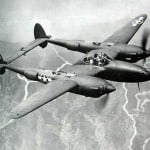 The P-38 (P-38G-10LO), a WWII era Fighter-Bomber was used in every combat theater of the war, was built by Lockheed and had a Length of 37′ 16″ and a wingspan of 52’. Today there are less than 30 of the 10,000 built. On the morning of May 28, 1943, the pilot took off from the North Island Naval Air station on Coronado Island, San Diego as part of a three-ship formation engaged in a low altitude formation dawn patrol and low level attack training flight.
The P-38 (P-38G-10LO), a WWII era Fighter-Bomber was used in every combat theater of the war, was built by Lockheed and had a Length of 37′ 16″ and a wingspan of 52’. Today there are less than 30 of the 10,000 built. On the morning of May 28, 1943, the pilot took off from the North Island Naval Air station on Coronado Island, San Diego as part of a three-ship formation engaged in a low altitude formation dawn patrol and low level attack training flight.
Twenty minutes later, the three were flying low (75’) above the water north of La Jolla and one and a half miles off shore. It was a nice day with visibility at ten miles and a 1500’ ceiling. The group of three began a right turn when, the pilot, on the inside, decided to change his position and drop down and behind. Caught in the prop wash of one of the planes, his P-38 rolled to the right and the right wing tip and engine touched the water. He immediately pulled back on his stick and was able to get the P-38 few feet off the ocean when he realized the prop blades were badly bent and wind milling. He thought he could make it to shore on the left engine and turned east, only to find that his left engine was also damaged and airspeed was now dropping.
The pilot now prepared to ditch his plane the best he could by prolonging his glide. He then opened the canopy and braced himself as he pancaked into the water. Once the plane stopped in the water, the pilot quickly jumped out of the cockpit, on to the wing and into the water as his P-38 nosed over and sank.
Meanwhile the other two pilots continued flying north another eight to ten miles before they noticed the plane was missing. Turning back to retrace their course, they spotted an oil slick on the water and the pilot waving his arms. One of the pilots radioed for assistance and then they both circled overhead for an hour until a Navy crash boat picked up the downed pilot from the water. His only injuries were four minor cuts to his scalp from when the canopy was released.
Some 51 years later in 1995, a Cessna was lost in the area and Dave Miller was hired to locate the plane and its cargo of bank checks. Using side scan sonar, Dave discovered the P-38 and an F-4 Phantom nearby. The P-38 had been a sought-after dive for many years and now that the elusive coordinates are out there has been several charter dive boats that take divers to the site.
Diving the P-38 is a fun deep dive, not to mention it is one of a few airplanes that are diveable in Southern California. The P-38 sits upright on a sandy bottom predominately intact with one of her four 20mm cannons still intact and with ammo still in the magazine. She is a short distance off Torrey Pines State Beach in 130’ of water with a relief of only 5’-7’ feet and is a short ride from Mission Bay. Despite the number of divers that have visited the wreck, it remains remarkably intact and undisturbed.
Diving the P-38 can be a very memorable experience, especially when the conditions are good. There’s nothing like gliding down the line and seeing the shape of a plane wreck. As you get close all you can think of is “how cool is this”. As you cruise around the wreck your thoughts wander thinking “what would it be like to fly one of these” and then you see a wolf eel and think you better check your bottom time as you only have a short stay at 130’. As you descend, you can only think “I have to come back”.
To read more about the P-38 and learn more about wreck diving, please visit the California Wreck Divers (CWD) website.
The Hogan
 The Hogan (DD-178) was launched by Union Iron Works, San Francisco, Calif., on April 12, 1919 and commissioned October 1, 1919 then in November 1919 she joined the Pacific Destroyer Force in San Diego. She was 314′ x 31′ and boasted four 4″ guns and two 20mm anti-aircraft guns. The Hogan served a short time and was decommissioned in San Diego May 27, 1922.
The Hogan (DD-178) was launched by Union Iron Works, San Francisco, Calif., on April 12, 1919 and commissioned October 1, 1919 then in November 1919 she joined the Pacific Destroyer Force in San Diego. She was 314′ x 31′ and boasted four 4″ guns and two 20mm anti-aircraft guns. The Hogan served a short time and was decommissioned in San Diego May 27, 1922.
She was recommissioned August 7, l940 and underwent a conversion to a high-speed minesweeper and was then reclassified as a DMS-6. Between 1940 and 1945 the Hogan had a very distinguished career spanning across the globe as a minesweeper and convoy escort. She took part in the invasion of North Africa as well as the battle of Iwo Jima. In April 1945 she went to San Diego to undergo major repairs and was reclassified as an AG105 on June 5, 1945. The veteran ship was assigned as a target ship for bombing tests and was sunk off San Diego November 8, 1945.
The Hogan received six battle stars for World War II service.
She now lies in 125 feet right on the Mexican Border. Currents are common in the area and visibility can be 10’-50’. With most of the structure collapsed, there is not much in the way of penetration.
To read more about the Hogan and learn more about wreck diving, please visit the California Wreck Divers (CWD) website.
The Ruby E
 The Ruby E began her life as the Coast Guard Cutter named Cyane (WPC-105) and was built in 1934 in Seattle Washington. She was 165’ long and designed to intercept “rum runners” during prohibition years. She was built to travel fast to reach and pursue the rum runners that were operating along the entire West Coast.
The Ruby E began her life as the Coast Guard Cutter named Cyane (WPC-105) and was built in 1934 in Seattle Washington. She was 165’ long and designed to intercept “rum runners” during prohibition years. She was built to travel fast to reach and pursue the rum runners that were operating along the entire West Coast.
The only problem with this was, she was completed after prohibition ended and was now not needed for her original purpose so the Coast Guard found a new purpose for her off the Alaskan coast where she served for 16 years, until she was decommissioned in 1950. Her career included Bering Sea and Alaskan Anti-Submarine Patrols during WWII.
In 1954, she was sold, renamed the Can Am and converted into a fish-processing vessel with several modifications and afterwards she was sent to fish the waters off Central and South America. Sometime afterwards she was reportedly impounded by customs officers in South America for drug smuggling.
Sold again, the Can Am was renamed the Ruby E and outfitted as a salvage vessel. She was seized as bank repossession because the owners could not repay their bank loans and she sat in San Diego harbor until purchased by the San Diego Tug and Barge Company.
After being scrapped the Ruby E was donated to be sunk in wreck alley as a dive attraction and artificial reef off Mission Bay. After being environmentally cleaned and made accessible to divers by cutting holes in various parts of the ship she was ready to take her place on the ocean floor in Wreck Alley.
The morning of July 18, 1989 she was towed to a planned location off Mission Beach and anchored. The sea cocks were opened and it was hoped she would fill up with water and sink. The spectators watching the sinking waited and watched. By noon, the ship was still afloat with only a slight starboard list. Unknown to planners, two secret compartments were hidden in the bulkheads fore and aft of the engine room. These sealed compartments were used to hide drugs during its smuggling days and now prevented her from sinking.
Local lifeguards brought several large pumps onboard to speed up the flooding. It took a while and finally, at 3:30 PM the lifeguards were forced to abandon the Ruby E as she began to sink. With her stern leading the plunge, she rolled briefly onto her starboard side as seawater approached her amidships. Suddenly, her bow and forward compartment shot straight up into the sky, before slowly sinking to the bottom where she has become an excellent addition to Wreck Alley.
Diving the Ruby E can be awesome on those perfect days when the visibility is at its best. For the most part she sits upright in 85’ of water on a sand bottom. She is intact and with her being made diver friendly she is easy to dive. For the experienced and certified wreck divers there are areas that can be penetrated. Visibility can be 10’-70’ and on average is 15’-20’. Water temperature is usually 50’s to 60’s depending on the time of year. Most of the wreck is covered with growth, such as strawberry anemones and a small kelp bed on top of the wheelhouse.
To read more about the Ruby E and learn more about wreck diving, please visit the California Wreck Divers (CWD) website.
High Seas
The High Seas was originally built at the San Pedro boat works in 1945, she was a Yard Patrol craft designated YP-621. At 128 feet in length she was a pretty good sized boat. After the war she was sold as surplus and converted into a Purse Seine fishing vessel. In 1970 she was cruising home in rough seas when the stern suddenly opened up. At the last second a small skiff was launched and the crew escaped just before she slipped beneath the waves with a full load of tuna on board.
Today the High Seas lies in approx. 110’ of water. She was a wood hulled vessel and has deteriorated significantly, presenting little opportunity for penetration. Now the wreck is more a debris field and home to lots of life, including some large ling cod and rockfish with the visibility between 5’-40’ plus. She is also covered in old netting, which makes it a hazardous dive for both divers and local marine life. The wreck has been relatively untouched.
